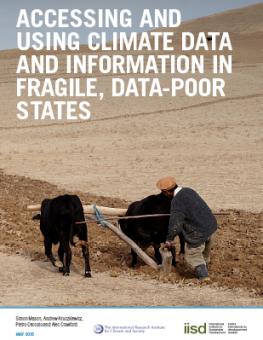
Accessing and Using Climate Data and Information in Fragile, Data-Poor States
The vulnerability of populations in fragile states to weather and climate variability is typically much higher than in other countries. These countries, and their populations, face a higher exposure to climate change as a result of their geography.
They are also over-reliant on climate-dependent sectors of the economy, particularly rain-fed agriculture, and their histories of violence, poverty and weak governance serve to undermine resilience and capacities to respond to climate risks. As such, climate change poses a significant challenge to the transition of fragile states toward peace and stability. In order to address and reduce the risk that climate change and variability may pose to a fragile state’s population and to peacebuilding progress, policy- makers and peacebuilding practitioners must be able to access, understand and use information on the local, national and global climate. However, it is within these fragile contexts that climate information is often the weakest, if it exists at all.
This report provides peacebuilding practitioners with guidance for accessing and using climate data and information in fragile contexts. It describes some of the challenges to generating, accessing and understanding climate information in contexts of state fragility. It introduces the types of climate information relevant to national and international peacebuilding practitioners operating in fragile contexts and provides a review of relevant and accessible climate data. The report addresses how climate information can be effectively used in a peacebuilding context, and highlights some of the immediate priorities and sequencing needs for fragile states attempting to rebuild their national capacities to generate climate information.
Participating experts
You might also be interested in
Promoting Climate-Resilient Peacebuilding in Fragile States
Pragmatically Integrating Sustainability Into the Reconstruction of Ukraine
IISD's brief investigates the pragmatic implementation of sustainability measures for rebuilding Ukrainian cities and looks into tangible solutions ready to be implemented during and after the war.
Peace, Conflict, and National Adaptation Plan Processes
How can we do more to consider peace and conflict dynamics in climate change adaptation? Read our new guidance note to effectively initiate NAP processes while navigating conflict dynamics.
New initiative harnesses power of nature to build resilience and protect biodiversity
The Climate Adaptation and Protected Areas (CAPA) initiative will use nature-based solutions to support local communities in adapting to climate change while safeguarding critical ecosystems in and around protected areas.